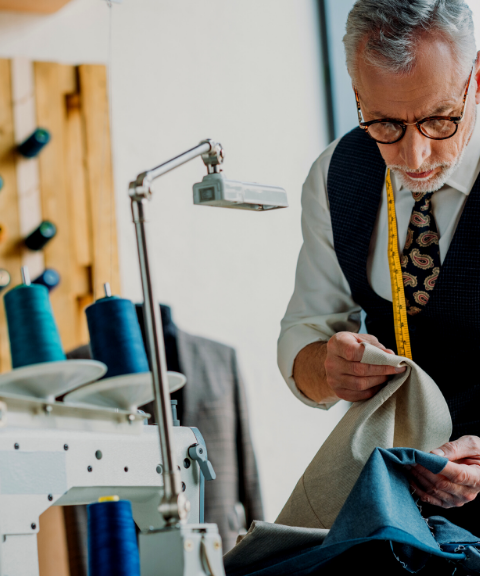Tailor Perth Specialists: Tailor-Made Solutions for Elegant Clothing
Wiki Article
Comprehending the Tailoring Refine: From Fabric Option to Last Suitable for the Perfect Closet
The tailoring procedure is a complicated interaction of art and science, starting with the critical choice of textile choice and finishing in the precise modifications of last fittings. Each material type brings unique top qualities that influence not only the aesthetic appeal yet additionally the garment's longevity and suitability for numerous celebrations. Understanding the nuances of tailoring strategies can elevate one's closet to unmatched degrees of elegance. As we discover these elements further, one should consider exactly how even the smallest information can considerably influence the overall result of one's individual design.Relevance of Material Option
Choosing the best fabric is vital in the tailoring process, as it directly affects the convenience, longevity, and overall aesthetic of the last garment (tailor perth). The selection of textile sets the structure for the garment's performance, efficiency, and design. Various materials have special properties, such as stretch, breathability, and weight, which can dramatically affect how the garment drapes and fits the bodyAdditionally, textile selection affects the garment's longevity and simplicity of treatment. High-grade textiles can hold up against deterioration, preserving their look and framework over time, while lower-quality materials might lead to pilling or fading. In addition, the best textile adds to the garment's ability to transition across seasons and events, thus boosting flexibility.
A tailored piece made from an ideal material not only showcases craftsmanship but also raises the user's self-confidence. Consequently, recognizing the subtleties of fabric option is vital for any tailoring venture. It makes certain that the last item not only fulfills the visual desires of the client but likewise aligns with functional demands, consequently accomplishing an unified equilibrium between kind and feature in the customized wardrobe.
Types of Fabrics and Their Usages
Recognizing the various kinds of materials readily available is crucial for making educated choices throughout the customizing procedure. Each fabric possesses one-of-a-kind features that dictate its suitability for certain garments and events.Its versatility allows it to be customized right into everything from shirts to outfits. Its natural flexibility helps garments maintain shape over time.
Silk radiates high-end and is light-weight, making it best for eveningwear and fragile blouses; nevertheless, it requires cautious handling as a result of its fragility. Linen, with its textured finish, is a popular selection for warm climates, supplying a ventilated and crisp feeling, but it wrinkles easily, which might affect the garment's appearance.
Artificial fabrics, such as polyester and nylon, offer toughness and resistance to wrinkles, making them appropriate for day-to-day wear and energetic garments. Understanding these material kinds and their residential or commercial properties permits better decision-making, making certain that each customized item not just fits well yet likewise straightens with the designated objective and event.
The Tailoring Strategies Described
The art of customizing counts on a range of methods that transform fabric into well-fitted garments. Central to this process is pattern composing, where a dressmaker produces design templates based on the customer's dimensions and wanted design. This preliminary action ensures that the garment will certainly fit the wearer properly before any type of cutting occurs.When patterns are developed, reducing techniques enter into play. Accuracy is critical as errors can result in misfitting garments. Tailors commonly make use of various cutting approaches, such as single-layer reducing for intricate designs and multiple-layer reducing for performance on basic patterns.
Basting is another necessary method, allowing dressmakers to momentarily stitch material assemble for a preliminary installation. This method uses the possibility to examine the drape and general shape prior to final stitching.
Seaming strategies, including flat-felled seams and French seams, boost the garment's durability and visual appeal. Tailors additionally employ techniques such as interfacing and extra padding to provide structure and form to certain areas, like collars and shoulders.
Finally, ending up techniques, including hemming and side ending up, ensure the garment's long life while supplying a sleek look. Together, straight from the source these methods develop the backbone of reliable customizing, resulting in charming, custom-fit apparel.
Fitting Adjustments and Considerations

Trick considerations include the shoulder fit, which needs to neither sag nor limit movement, and the sleeve size, which should permit for comfortable arm movement while maintaining a refined look. Additionally, adjustments at the waist can refine the silhouette, with options to allow out or take in fabric as needed.
The increase of pants is one more critical factor; it needs to rest conveniently above the hips without causing pain, enabling for simplicity of movement. Hemming lengths for both pants and skirts need to reflect the user's preferred design while appreciating percentages.

Maintaining Your Tailored Garments
Appropriate upkeep of customized garments is important to protecting their fit and appearance over time. To guarantee long life, normal cleansing is paramount. Always follow the treatment label directions, which might suggest completely dry cleansing for delicate materials or equipment cleaning for even more long lasting materials. Stay clear of frequent laundering, as this can wear down the material and alter the garment's shape.Storage space is equally vital; usage cushioned wall mounts for coats and coats to keep shoulder structure, and store trousers folded up nicely or hung to avoid creasing. Secure garments from direct sunshine, which can fade shades and damage fibers.
Additionally, routine evaluations for small fixings can protect against bigger concerns. Look for loose switches, tearing seams, or signs of moth damage, dealing with these problems without delay to preserve the garment's honesty.
Lastly, think about seasonal rotation. Using tailored pieces in moderation enables textiles to recoup, expanding their lifespan. By executing these upkeep approaches, you can make certain that your tailored garments stay as pristine as the day you initially used them, enhancing your suitable wardrobe for many years to find.
Conclusion
The tailoring process, including material selection, competent methods, and precise suitable changes, plays an important role in creating garments that boost both convenience and style. Comprehending the value of upkeep extends the life of customized garments, strengthening their worth in a well-curated closet.Picking the appropriate fabric is crucial in the tailoring process, as it straight influences the convenience, longevity, and overall aesthetic of the final garment. The choice of textile establishes the foundation for the garment's performance, style, and capability. Different materials possess special buildings, such as breathability, stretch, and weight, which can significantly impact how the garment drapes and fits the body.
The art of customizing relies on a variety of techniques have a peek at this site that transform material right into well-fitted garments.The tailoring process, encompassing fabric selection, knowledgeable strategies, and precise fitting changes, plays a vital duty in creating garments that boost both comfort and style.
Report this wiki page